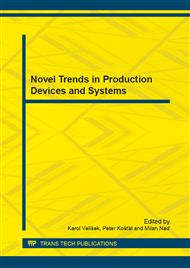p.200
p.206
p.212
p.218
p.224
p.230
p.236
p.242
p.249
Investigation of the Surface Quality when End–Ball–Milling Form Surfaces with Sequence of the Radii Ratio
Abstract:
This paper deals with a methodology of identifying surface quality when endball milling form surfaces which are applied in tool making. This methodology was developed for the 3D milling process and it consists of following parts as design of the samples, surface milling and checking surfaces with different sequence of radii ratio. That sequence was used to model real form surfaces applied in tool making. Based on the defined measurability of the surface roughness, two milling strategies have been applied to produce radii sequence. In order to prevent undesired cusp formation in the 3D milling, the response surface methodology and statistical analysis are used to evaluate surface quality.
Info:
Periodical:
Pages:
224-229
Citation:
Online since:
January 2014
Authors:
Price:
Сopyright:
© 2014 Trans Tech Publications Ltd. All Rights Reserved
Share:
Citation:


